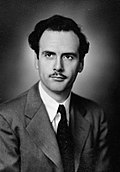Understanding Media
Understanding Media: The Extensions of Man is a 1964 book by Marshall McLuhan. It was a pioneering study in media theory. McCluhan was a Professor of literature who was deeply interested in the way media had changed society.
| Author | Marshall McLuhan |
|---|---|
| Country | Canada |
| Language | English |
| Subject | Media theory |
| Publisher | McGraw-Hill |
| ISBN | 81-14-67535-7 |
The book proposes that media themselves affect their content in important ways. It is an attempt to understand how changing media have affected society. McLuhan suggests that media play a role, not by the content delivered, but by the characteristics of the medium itself.
McLuhan pointed to the light bulb as an example. A light bulb does not have content in the way that a newspaper has articles or a television has programs, but it is a medium that has a social effect. The light bulb lets people do things at nighttime which would be impossible in darkness. He describes the light bulb as a medium without any content. McLuhan states that "a light bulb creates an environment by its mere presence".[1]
More controversially, he thought that content had little effect on society — for example, it did not matter if television broadcasts children's shows or violent programming — the effect of television on society would be identical. He noted that all media have characteristics that engage the viewer in different ways; for instance, a passage in a book could be reread at will, but a movie had to be screened again in its entirety to study any individual part of it.[2] He made the point that reading, by its very nature, is a sequential medium. One reads it in a sequence. On the other hand, a medium like film presents information more holistically. There is a kind of "all at once-ness" about films and television.
The book is the source of the well-known phrase "The medium is the message". It was a leading indicator of the upheaval of local cultures by increasingly globalized values. The book's influence spread much further than academics, writers, and social theorists. It was widely read.[3] It became a corner-stone in media studies courses.[4][5]
Understanding Media Media
Communication technology's impact on Western culture. Print culture generates the most socially revolutionary and eversive forces, while electric media makes people more reactionary.
References
- ↑ Understanding Media, p. 8.
- ↑ Not so true now, when we have access to digital versions.
- ↑ Plummer, Kevin. "Historicist: Marshall McLuhan, urban activist". www.torontoist.com. Archived from the original on January 31, 2023. Retrieved September 20, 2011.
- ↑ "Programming: getting the message". Time. October 13, 1967. http://www.time.com/time/magazine/article/0,9171,837382,00.html. Retrieved 3 March 2011.
- ↑ Stille, Alexander (14 October 2000). "Marshall McLuhan is back from the dustbin of history; with the internet, his ideas again seem ahead of their time". The New York Times: 9. https://www.nytimes.com/2000/10/14/arts/marshall-mcluhan-back-dustbin-history-with-internet-his-ideas-again-seem-ahead.html. Retrieved 10 March 2011.
